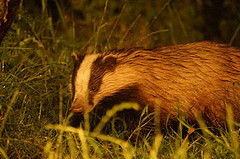Badger Habits
Territory: badgers live underground in large burrow systems called setts. A sett is usually dug in sloping ground in a wood or copse bordering pastureland. Some setts have been used for over 100 years by generations of badgers and may have more than 40 entrances. The underground tunnels may be up to 30m long. Tunnels are on different levels, about 100cm from the surface. At the end of a tunnel is a chamber, used for sleeping or breeding. A badger community normally consists of several adult boars (males) and sows (females) together with one or two litters of cubs - up to 15 animals in total. A community's territory may be 90-120 acres in size.
 Daily life: badgers are nocturnal and emerge from their setts soon after dusk, sniffing the air for danger before going about their activities. They are very clean animals and always deposit their droppings in shallow pits some distance from the sett. Bedding material is also changed frequently. Straw, bracken, dry leaves etc. are gathered between the forepaws and the badger shuffles backwards to the sett entrance.
Daily life: badgers are nocturnal and emerge from their setts soon after dusk, sniffing the air for danger before going about their activities. They are very clean animals and always deposit their droppings in shallow pits some distance from the sett. Bedding material is also changed frequently. Straw, bracken, dry leaves etc. are gathered between the forepaws and the badger shuffles backwards to the sett entrance.
Near the sett there is usually a "scratching tree", engraved with sets of parallel claw marks. Sharpening claws keep them in good condition for digging.
Before going off to forage for food along well-used paths throughout their territory, badgers may spend some time around their sett. Half-grown cubs enjoy playing with each other, chasing, jumping and tumbling - the adults often join them. They like to groom each other too. Badgers in the same group recognise each other by scent; one badger "musks" another by backing onto it with its tail raised to secrete a strong-smelling liquid from a gland under its tail.
Winter: during the autumn, badgers eat as much as they can, laying down a lot of fat under the skin, increasing their weight by up to 6%. This helps them to survive the winter. They do not hibernate but spend the coldest weather sleeping in their setts, living mainly off their fat.
Breeding: badgers may mate in any month between February and October but the fertilised egg does not start developing until December. This is called delayed implantation. The cubs are born about eight weeks after implantation, from mid-January to mid-March. There are usually two or three cubs in a litter and to begin with they are blind and have silky, greyish-white fur. They remain underground until they are 8 weeks old and weaning starts at 12 weeks of age. Some cubs stay with the family group and others leave to find new territories. Females are ready to breed at 12-15 months, males take longer, usually maturing by the age of two.
Read More: Badgers and Humans